 |
 |
 |
|
 |
| |
|
Observations
of Var Her 04, a newly discovered CV After
the discovery announcement of Var Her 04 by Nakamura
(Japan), I had a first opportunity to observe this
new cataclysmic variable on June 24th, 2004. Its
position is RA = 18h39m26s, Decl = +26°04'10"
(J2000.0).
2004, June
24/25
Skies were clear on Jun 24/25 for most of
the night, but strong winds reduced the overall
quality of the run, which lasted for 0.11 d. I used
a 0.35-m f/6.3 telescope and unfiltered ST-7XME CCD
camera. The
resulting light curve is depicted below. It clearly
shows (super?)humps, with an average amplitude of 0.10
mag. It also shows the presence of an eclipse-like
dip (around JD +3181.463) with an amplitude of 0.07
mag.
Using Peranso, I deduced a preliminary
hump period value of 0.057 +/- 0.009 d (PDM
method). The
high uncertainty is due to the short observing
window. The value is in good agreement with results
obtained by other CV colleagues.

Var Her 04 lightcurve on Jun
24/25, 2004. Unfiltered CCD observations at CBA
Belgium Observatory,
using a 0.35-m f/6.3 SCT telescope and ST-7XME CCD.
2004, June
25/26
June 25/26, 2004
again was a clear nigth, with less winds, and
therefore yielding a better accuracy in the overall
light curve (see below). I
observed Var Her 04 for 3.9 hours (unfiltered CCD),
and captured 3 humps. Again, there's a dip
superimposed on the hump, but this time less
pronounced than during the Jun 24/25 observations.
However, the hump profile itself has a clearer
signature, closer to a typical superhump profile.
Using a total of 416 observations (2 nights), I
looked for periodic signals in Var Her 04's
lightcurve, using 4 different methods (in Peranso) :
ANOVA, PDM, Dworetsky and Lomb-Scargle.
ANOVA, PDM and Dworestky are
statistical methods for period determination,
whilest Lomb-Scargle is a Fourier method.
Yet, all four methods yield a consistent
(super?)hump period value of 0.0579 +/- 0.0002 d,
so we may assume that this period is already fairly
accurate.

Var Her 04 lightcurve on Jun 2
5/26,
2004. Unfiltered CCD observations at CBA Belgium
Observatory,
using a 0.35-m f/6.3 SCT telescope and ST-7XME CCD.
I have included the ANOVA period window below, as
well as the Var Her 04 light curve folded on the
reported period. The phase diagram shows an average
hump amplitude of 0.14 mag.
|
 |
|
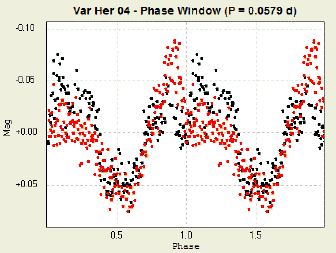 |
|
|
Var Her 04
period analysis window, using the ANOVA method.
Significant period at 0.0579 d. |
|
Var Her 04
phase window, showing the light curve folded
over a period of 0.0579 d. |
|
2004, June 27/28
Another clear night on June 27/28, 2004 over CBA
Belgium Observatory, and again completely used to
monitor Var Her 04. The resulting light curve
(below) shows a number of intruiging, but hard to
explain modulations, that arise over various parts
of the superhump profile. In some cases, Var Her 04
drops by almost 0.15 mag in a couple of minutes.
This might again be eclipses, reappearing in the
light curve. Michael Richmond's observations,
obtained on the same night, confirm the irregular
modulations.
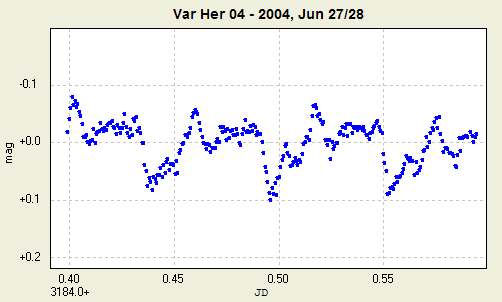
2004, June 28/29
Apart from some initial clouds, the
night of June 28/29, 2004 again was clear over CBA
Belgium Observatory. Var Her 04's light curve is
depicted below, and is once more very different from
previous night. In addition to superhumps, the curve
clearly shows a fading trend, which is the onset of
a rapid dimming of Var Her 04 (observed in detail on
June 30th, at which moment it was cloudy over
Belgium).
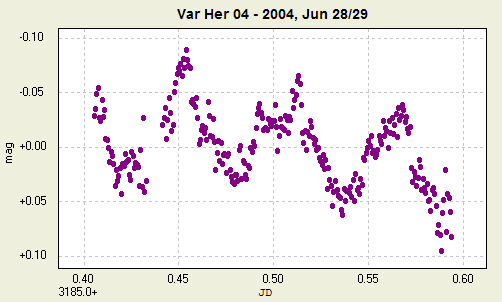
2004, July 01/02
Poor summer weather over Belgium
equals poor nights. So, we missed the decline of Var
Her 04, and had to wait till Jul 01/02 to again
observe the variable at CBA Belgium Observatory. At
mag 15.2, and with strong moonlight, this was not an
easy target, and the noise in the light curve (see
below) clearly has increased. Yet, a hump like
profile is still visible, with an amazing amplitude
of about 0.3 mag.
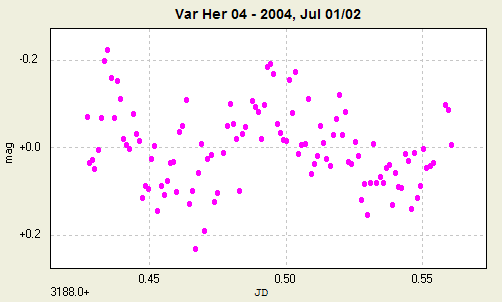
2004, Jul 03/04
During the night of Jul 03/04, Var
Her 04 was fluctuating around mag 15.2 (unfiltered),
showing a modulation of about 0.2 mag. No dimming or
rebrightening trend was visible.

2004, Jul 05/06
This night, Var Her 04 initially was
around mag 15.4 (unfiltered), but then showed a
sudden fading by 0.15 mag over a very short period.
The variable then remained 'steady' around mag 15.6
- 15.7. I tried a period analysis on the this
dataset, and the one above, but no conclusive
results were obtained.
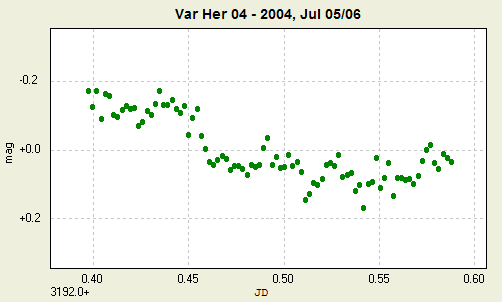
2004, Jul 06/07
This night, Var Her 04 initially was
around mag 15.6 (unfiltered), i.e. still slowly
fading. At the same time, the variable continues to
show irregular hump like modulations of about 0.2
mag.
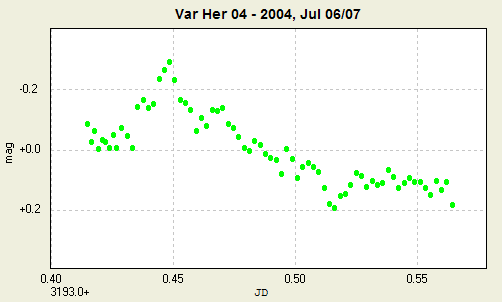
|
|
|
 |
|
 |
|
|
 |
Copyright © 2004 - Tonny Vanmunster.
|
 |
|
 |